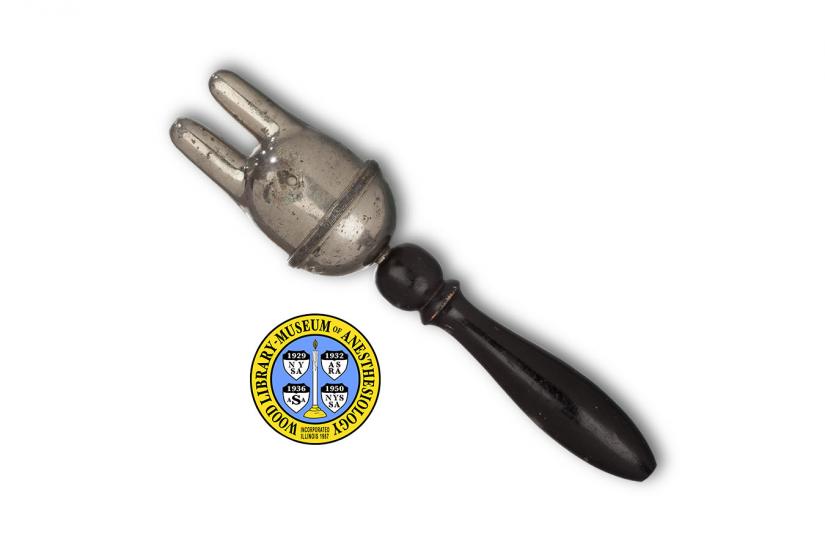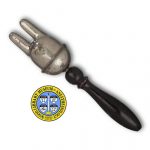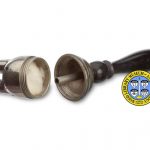Reynold Inhaler
Reynold Obstetrical Chloroform Inhaler
Self-administration inhalers allow patients to administer medications, including anesthetics, to themselves. Since the 18th Century, they have been used to relieve ailments such as colds, headaches and asthma. Self-administration anesthetic inhalers for women in labor were used in the early and mid-20th Century. The Reynold Obstetrical Inhaler was available from around 1900 through the 1920s. It contains cotton batting, which would have been soaked with chloroform just before use. Because chloroform is such a potent anesthetic, very little of it was needed. The tips of this inhaler are set far apart to prevent them from becoming stuck in the patient's nostrils, which could lead to an overdose. Later self-administration inhalers, such as the Duke Inhaler and the Abbott Analgizer, added a bracelet so that when the patient had had enough to become drowsy, the device would not be dropped on the floor.
Catalog Record: Reynold Inhaler A27.Reynold Inhaler
Access Key: akoj
Accession No.: 2002-03-17-3
Title: [ Reynold’s obstetrical chloroform inhaler.]
Title variation: Alt Title
Title: Reynold inhaler.
Title variation: Alt Title
Title: Reynolds obstetrical inhaler.
Title variation: Alt Title
Title: Reynold’s Obstetrical Chloroform and Ether Inhaler.
Title variation: Alt Title
Title: Reynold self-administration chloroform inhaler.
Publisher: [Place in manufacture not indicated] : [manufacturer not indicated], [1905-1930].
Physical Description: 1 inhaler ; metals, wood ; 18 x 4 x 4 cm.
Subject: Inhalers, Anesthesia.
Subject: Anesthesia, Inhalation – instrumentation.
Subject: Anesthesia, Obstetrical.
Subject: Analgesia, Obstetrical.
Subject: Chloroform – administration & dosage.
Subject: Self Administration.
Web Link: http://woodlibrarymuseum.org/museum/item/673/reynold-inhaler
Note Type: General
Notes: The early date in the date range for the possible year of manufacture is roughly based on the date of the catalog in which the earliest advertisement or such an inhaler was found (1909 Betz catalog). The end date is a very rough estimate based on the date of the latest advertisement accessed for such a device (a 1927 Betz catalog). The date range could change if new documentation that indicates that the dates should be corrected. The date range could change if new documentation that indicates that the dates should be corrected.
Note Type: General
Notes: There are no visible manufacturer markings on the inhaler. Title based on the earliest advertisement accessed for such an inhaler. A device that is very similar except for the shape of the wooden handle was found in a 1909 catalog of the manufacturer Frank S. Betz Company. In a catalog published in 1915 or 1916 the inhaler is called the, “Reynold’s Obstetrical Chloroform and Ether Inhaler”. In a 1927 Betz catalog the device is called the “Reynold’s Obstetrical Inhaler.” The title could change if new documentation that indicates that the dates should be corrected.
Note Type: Citation
Notes: Bause G. Hart’s chloroform analgesia by “Reynolds Obstetrical Inhaler”. Anesthesiology. 2011;115(6):1146.
Note Type: Citation
Notes: BETZCO Annual Fall Sale Physicians & Surgeons Supplies. Hammond, Indiana: Frank S. Betz Company; 1927:15.
Note Type: Citation
Notes: Catalogue of surgical Instruments, Hospital and Office Furniture, Beds … and Everything in the Line of Physicians’ and Hospital Supplies. Hammond, Indiana: Frank S. Betz Company; 1909.
Note Type: Citation
Notes: Cheeley LN. Use of chloroform in obstetrics. Anesth Analg. 1950;29(3):177-179.
Note Type: Citation
Notes: Chisholm inhaler. Waring Historical Library website. http://lowcountrydigital.library.cofc.edu/cdm4/item_viewer.php?CISOROOT=/wac&CISOPTR=179&CISOBOX=1&REC=13. Accessed November 14, 2013.
Note Type: Citation
Notes: Hart LM. Obstetrical practice. J Am Osteopath Assoc. July 1918;17(11):610.
Note Type: Citation
Notes: Original communications: obstetrical anesthesia. Med World. June, 1919;37(6):208.
Note Type: Citation
Notes: Progressive Equipment. Hammond, Indiana: Frank S Betz Company; 1915-1916:179.
Note Type: Physical Description
Notes: One nasal inhaler composed of an oval shaped hollow sphere with two parallel extensions for nasal inhalation at one end and a wooden handle at the other; The oval sphere measures approximately 5 cm x 4 cm, and the nasal extensions measure approximately 2.5 cm in length and 1 cm in diameter; There are four holds in the sphere of the inhaler, and a hole at the end of each extension for the nostrils; The top portion of the sphere can be unscrewed from the bottom portion to insert cotton wet with chloroform; A metal tube that is continuous with the hollow center of the handle extends from inside the bottom portion of the sphere toward the center; The wooden handle measured approximately 10.5 cm in length and 2 cm in diameter at its widest; The proximal end (based on the patient’s perspective) is open and continuous with the opening in the metal sphere; The handle has been shaped in a simple decorative manner that might also ease holding the top heavy device; The wood is stained a dark brown; There are no manufacturer markings; There are a number of small scratches on the metal and wood.
Note Type: Reproduction
Notes: Photographed by Mr. Steve Donisch, June 12, 2013.
Note Type: Historical
Notes: This type of nasal inhaler, dating from about 1905 to 1930, was intended for the self-administration of the anesthetic chloroform by women in labor. The metal sphere opens so that cotton soaked with chloroform could be inserted. There is an opening at the tip of each nasal extension. For use, the patient would put the tip of these extensions to her nose. When she inhaled, air pulled through small openings in the body of the inhaler, and at the very end of the hollow wooden handle, would be drawn through the chloroform-soaked cotton and a dose of the anesthetic was delivered to her lungs. She could inhale as many times as needed. If she lost consciousness the inhaler was dropped.
Note Type: Historical
Notes: This type of inhaler was used during the early 20th century when most women gave birth at home. These inhalers were portable and easy to use. Women liked them because it gave them some control over labor pain. The physicians who recommended them liked the simplicity and believed the use of chloroform via this method was safe. Chloroform was quick-acting and relatively inexpensive, but it did pose a risk for life-threatening heart complications.
Note Type: Historical
Notes: Although there are no manufacturer’s marks on the device described here, it looks very much like inhalers made by the Frank S. Betz Company based in Hammond, Indiana.
Note Type: Historical
Notes: The Reynold’s Inhaler was not the only nasal inhaler for anesthesia and pain relief. An early nasal inhaler was designed by Dr. John J. Chisholm (1830- 1903), a Confederate medical officer who cared for wounded soldiers at Fort Sumter. The Waring Historical Library has an example of a Chisholm Inhaler that may be viewed in their online catalog at http://lowcountrydigital.library.cofc.edu/cdm4/item_viewer.php?CISOROOT=/wac&CISOPTR=179&CISOBOX=1&REC=13. Another nasal inhaler for obstetrical pain relief, called the Bennett Inhaler, was made by the J.F. Hartz Company.
Note Type: Publication
Notes: Minnesota Med. 1938;21:39. *Full citation not obtained. From Google Books snippet view. The small amount of text that was viewable included, “Later on I resort to the Reynolds chloroform inhaler, which the patient can take herself, and she gets a great deal of relief, without anyone in attendance watching that particular case.” http://books.google.com/books?id=Io5FAAAAYAAJ. Viewed November 12, 2013.
Note Type: Publication
Notes: New York State J Med. 1928;28:18. *Full citation not obtained. From a Google Books snippet view. The small amount of text that was viewable included, “We used a little chloroform for 10 minutes with a Reynolds inhaler at the end of the Second state. The shoulders became … .” http://books.google.com/books?id=I7tYAAAAYAAJ. Viewed November 12, 2013.
Note Type: Exhibition
Notes: Chosen for the WLM website.



